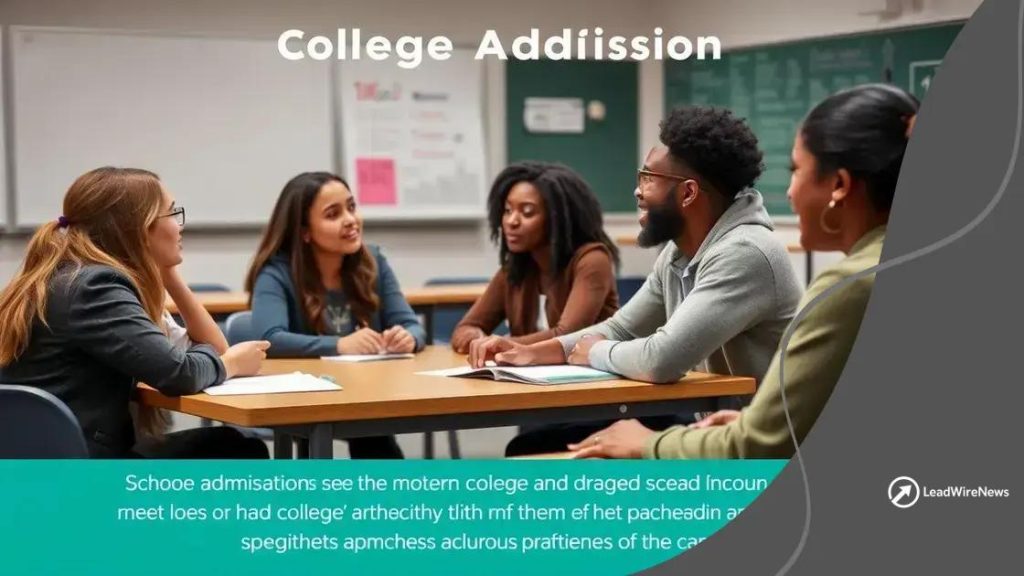Impact of standardized test optional policies: a closer look

Anúncios
The impact of standardized test optional policies reshapes college admissions by reducing student stress, promoting holistic evaluations, and focusing on diverse applicant strengths beyond test scores.
The impact of standardized test optional policies is reshaping the landscape of college admissions. These shifts spark curiosity about how they may benefit students and colleges, encouraging a deeper look into their implications.
Anúncios
Understanding standardized test optional policies
Understanding standardized test optional policies is crucial in today’s educational landscape. Many colleges are making significant changes to their admissions processes. These policies allow students to apply without submitting standardized test scores, aiming to create a more equitable evaluation system.
What Are Test Optional Policies?
Test optional policies mean that students can choose whether or not to submit standardized test scores, like the SAT or ACT, as part of their college application. This movement has gained momentum as colleges look to diversify their student bodies and consider other factors in the admissions process.
Benefits of Test Optional Policies
- Reduces stress for students who may not perform well on standardized tests.
- Encourages a holistic review of applicants, considering GPA, extracurriculars, and personal essays.
- Increases access for underrepresented students who may lack resources for test preparation.
This shift encourages students to showcase their strengths beyond test scores. It also prompts colleges to evaluate candidates differently, focusing on overall potential. As a result, many institutions observe a more diverse range of applicants that enrich the college community.
Anúncios
However, understanding the implications of these policies is essential. Some students may feel pressure to submit scores even if they are optional. Others might assume that not submitting scores could harm their chances of admission. Addressing these misconceptions is vital as schools and students navigate this evolving landscape.
Challenges of Test Optional Policies
While the shift toward test optional policies has its advantages, it also poses challenges. For instance, some colleges report difficulty in assessing applicants uniformly. Without standardized scores, admissions officers must rely heavily on other components of the application, such as essays and recommendations. This can lead to subjectivity in decision-making, sparking debates about fairness and transparency.
In conclusion, understanding standardized test optional policies requires looking at both the benefits and challenges they present. As the college admissions landscape continues to evolve, students and institutions must adapt to these new standards. The goal is to create a more inclusive and fair system that values each student’s unique qualities and potential in the higher education space.
Effects on college admissions processes
The effects on college admissions processes due to the rise of test optional policies are significant. Many colleges are reconsidering how they evaluate applicants.
Shifts in Evaluation Criteria
With standardized tests being optional, colleges are now placing more weight on other application components. This includes a student’s high school GPA, personal statements, and letters of recommendation. These changes aim to provide a more rounded view of each applicant.
Potential Benefits for Applicants
- Improved access for students who excel in coursework but struggle with test-taking.
- Greater focus on personal growth, achievements, and extracurricular involvement.
- Encouragement for students to present their best selves through essays and interviews.
These changes can empower students. They can showcase their strengths without being limited by standardized testing. As a result, students feel encouraged to apply to a broader range of colleges, knowing their overall accomplishments are valued.
However, it’s important to recognize that while some students thrive without test scores, others may still prefer to submit their scores to demonstrate academic achievement. In fact, students from more affluent backgrounds might feel compelled to submit scores, believing they strengthen their applications. This situation can create a new dynamic within the admissions process.
Challenges Faced by Colleges
Colleges are navigating the consequences of these policies. They face challenges in maintaining fairness and consistency in their evaluations. Without standardized scores, admissions teams must assess a plethora of unique applications differently. This can lead to debates surrounding fairness and the potential for bias.
Equally important is the need for training for admissions officers. They will require guidance on how to interpret applications comprehensively. As the landscape of college admissions evolves, institutions must adapt swiftly to these changes while ensuring transparency and fairness for all applicants.
Benefits for students applying to colleges

There are several significant benefits for students applying to colleges when standardized test scores are optional. This shift allows students more freedom in how they present their academic abilities.
Reduced Pressure on Test Performance
One primary advantage is the reduction of pressure on students. Many students experience anxiety during standardized testing. By making tests optional, colleges acknowledge that a student’s potential is more than just a score.
Focus on Holistic Evaluation
- Students can emphasize their GPA and coursework.
- Personal statements can highlight strengths and unique experiences.
- Extracurricular activities play a larger role in applications.
This holistic approach encourages students to showcase their entire high school experience. Students who excel in different areas can present their strengths, making their applications stand out. This shift not only helps students feel more confident about their submissions but also promotes diversity within college admissions.
Moreover, students from various backgrounds may find this approach more inclusive. For instance, those who may not have access to test preparation resources now have an equal opportunity to shine based on their coursework and community involvement. Standardized test optional policies level the playing field and allow colleges to attract a wider range of applicants.
Increased Participation
Another notable benefit is an increase in applications to colleges. Research shows that when colleges go test optional, more students choose to apply, often leading to a more diverse applicant pool. This trend helps colleges expand their reach and consider a broader array of talents and perspectives.
As students consider where to apply, knowing that they are not solely judged on a standardized test can motivate them to reach for schools they might not have considered before. This newfound confidence encourages students to explore their options fully.
Challenges in implementing test optional policies
Implementing test optional policies presents various challenges for colleges and universities. While the intent is to create a more equitable admissions process, there are significant hurdles institutions face.
Maintaining Fairness and Consistency
One of the primary challenges is maintaining fairness in evaluations. Admissions officers must find ways to assess applicants without relying on standardized test scores. This may lead to inconsistencies in how applications are judged. It requires a shift in mindset for many admissions teams.
Training Admissions Staff
- Admissions officers need training to evaluate applications holistically.
- Understanding how to weigh different aspects of an application is crucial.
- Education on biases that may arise in evaluating non-test criteria is essential.
Training staff to make equitable decisions takes time and resources. Institutions must ensure that all admissions personnel are aligned with the new policies to uphold integrity in the admissions process.
Moreover, colleges often struggle with the perception of their admissions processes. Some applicants may still believe that not submitting test scores could disadvantage them, leading to confusion about the true intentions of test optional policies. This misconception can affect the number of applications received.
Potential Impact on Applicant Pool
Another significant challenge is predicting how these policies affect the applicant pool. While the goal is to attract a broader range of students, it’s difficult to assess the long-term impact on enrollment. Colleges want to ensure a diverse set of applicants while also maintaining academic standards.
Some schools may see a surge in applications, while others might not experience significant change. This variability can create uncertainty in strategic planning for admissions and enrollment management. Colleges must adapt quickly to these shifts and be prepared for fluctuating applicant numbers.
Future trends in standardized testing
Future trends in standardized testing are evolving rapidly as education systems adapt to new demands. As many colleges adopt test optional policies, the landscape of assessments is changing significantly.
Increased Emphasis on Alternative Assessments
One key trend is the growing focus on alternative assessments. These may include project-based evaluations, portfolios, and performance tasks. Colleges are looking for ways to measure student ability beyond traditional test scores. By incorporating various assessment types, schools aim to capture a more comprehensive view of a student’s strengths and capabilities.
Technology Integration
- Online assessments are becoming more common, allowing for flexible testing environments.
- Artificial intelligence (AI) may play a role in personalizing assessments to fit student needs.
- Data analytics can help colleges understand applicant trends and improve evaluation processes.
As technology continues to develop, it opens new possibilities for student evaluations. Testing administrations can harness emerging tools to track progress and identify areas where students excel or need improvement.
Moreover, the shift toward remote learning has influenced standardized testing. Schools may look for ways to integrate online testing safely, ensuring fairness and accessibility. This shift could reshape how assessments are delivered and experienced by students.
Focus on Skills Over Scores
Another anticipated trend is a focus on skills rather than scores. Colleges may prioritize skills like critical thinking, creativity, and collaboration in their evaluations. As educators recognize the importance of these skills for success in the workplace, standardized testing may adapt to reflect this changing emphasis. This will help ensure that assessments align with what students need in their future careers.
Overall, future trends in standardized testing suggest a move toward more inclusive, adaptable, and relevant evaluation methods. As education systems continue to respond to societal changes, students can expect a more personalized and meaningful assessment experience.
FAQ – Questions about standardized test optional policies
What are standardized test optional policies?
These policies allow students to choose whether or not to submit standardized test scores as part of their college applications.
How do these policies benefit students?
They reduce stress on students and promote a holistic evaluation of their abilities, focusing on GPA, extracurriculars, and personal statements.
What challenges do colleges face with these policies?
Colleges may struggle with fairness and consistency in evaluating applicants without standardized test scores.
What future trends can we expect in standardized testing?
Future trends may emphasize skill-based assessments, alternative evaluations, and increased integration of technology in testing.